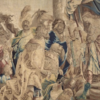Book Review: God’s Forever Family, by Larry Eskridge
Larry Eskridge, God’s Forever Family: The Jesus People Movement in America. Oxford University Press, 2013. 386 pages. $35.00.
Whether accompanied by wincing or waxing nostalgic, those Americans who came of age in the late 1960s and early 1970s tend to have colorful memories of the period. The era’s anti-establishment ethos expressed itself in the sexual revolution, hippies, war protests, communes, drugs, and rock-n-roll. Many teens and young adults embraced the style of the counterculture: long hair and beards, love beads, far out music, tie-die shirts and tasseled leather. And, for some of them, Jesus.
In God’s Forever Family, Larry Eskridge offers a comprehensive history of the movement initiated by those called “Jesus Freaks” or “Jesus People.” He argues that while the movement itself was short-lived—lasting roughly a decade beginning in 1967—it has had a substantial impact on American religious culture, particularly evangelicalism.
Like so much youth culture in that day, the Jesus People began in California, particularly in San Francisco. The “Summer of Love” in 1967 brought tens of thousands of young people to the Bay Area, with promises of peace, unity, and happiness. But in an environment of easy sex and drugs, many of these seekers and runaways instead found disillusionment, addiction, homelessness, and sexual predators.
Meanwhile, a small group of hippies who had come to Christ and begun to live communally worked with a local church-supported outfit called Evangelical Concerns to reach out to lost souls on the streets of San Francisco. Soon, evangelists like Ted Wise, Kent Philpott, and Lonnie Frisbee were competing with head shops and drug dealers, offering the enduring high of life with Jesus and his followers.
Hippie converts retained much of the spirit and trappings of the counterculture—minus the unrestrained sex and drugs—and combined them with a fervent desire to live out the teachings of Jesus in the modern world. They rejected the “old fashioned” tone of establishment churches and sought new ways to express Christian faith. For evangelical teens who may not have become hippies but still wanted to be cool, this provided an appealing concoction. Combined with hippies, these young people fueled the growth of the movement and helped it become a nationwide phenomenon.
The sense of heightened consciousness and outsized expectations that shaped the counterculture received Christian expression in the Jesus People movement. Jesus Freaks read the Bible with the full expectation that the mighty presence and power of God would be manifested in their experiences, just as in the apostolic church of the Book of Acts. Guided by this “Pentecostal ethos,” the movement stressed signs and wonders, communal living, and the imminent return of Christ (77). Eskridge suggests that after the Bible, Hal Lindsey’s dispensational premillennialist bestseller, The Late, Great Planet Earth (1970), was likely the most popular book among Jesus People. Amid a wayward culture careening toward destruction, the Jesus People saw themselves as a righteous remnant set apart by God in anticipation of the end times, their urgency fed by their apocalypticism.
Jesus People communes ran the gamut from numerous short-lived houses that offered shelter to counterculture refugees to extensive operations like the Shiloh communes and the Children of God, each with dozens of communal houses and thousands of members. The Children of God (later known as The Family International) in particular proved a divisive force in the movement, as their leader, David Berg, increasingly articulated heretical and perverse teachings, including a “free love” sexuality that included children from infancy onwards.
If communes reflected the full-commitment sensibility of the Jesus People, Christian coffeehouses offered a less demanding institutional form. Nearly everywhere Jesus People alighted they established coffee shops. These offered young folks a safe place to hang out, study the Bible, and listen to the kind of music that made their parents uncomfortable. Coffeehouses like Adam’s Apple in Fort Wayne, Indiana, and the Salt Company in Hollywood, California, were venues for the music that became the movement’s biggest draw and perhaps its most lasting influence. Eskridge argues that musical performers like Love Song, Second Chapter of Acts, and Larry Norman laid the groundwork for Contemporary Christian Music and the praise and worship music that has become so common in evangelical churches.
In the ecclesiastical realm, the Calvary Chapel network of churches trace their origins to the original Costa Mesa, California, congregation’s embrace of the Jesus People. Calvary Chapel pastor Chuck Smith originally viewed southern California beach hippies with contempt, but growing contact with Jesus People helped Smith see need and opportunity in these wayward youth. In short order, Calvary Chapel adopted the charismatic and casual style of the Jesus People, along with its music, and the resulting growth eventually led to dozens of daughter churches. Since the Vineyard Fellowship arose from a later break with Calvary Chapel, it also reflects the long-term influence of the movement, as do aspects of the “seeker-sensitive” churches of recent decades.
In popular consciousness, the Jesus People enjoyed a heyday in the early 1970s, as both secular and evangelical media highlighted the phenomenon and cultural productions like Jesus Christ Superstar andGodspell (cue wincing and nostalgia) achieved some measure of popularity. But by the mid-to-late 1970s, the Jesus People were fading from view. This correlated with the diminishment of the counterculture in general, but it also reflected the extent to which aspects of the movement were incorporated into the broader realm of evangelicalism.
Eskridge notes that the “high water mark” of the Jesus People movement was EXPLO ’72, a five-day series of rallies and seminars in Dallas attended by 85,000 youth, punctuated by a day-long closing music festival with an estimated attendance of 180,000 (169). Notably, whereas the iconography and sounds of “Godstock” reflected the Jesus People, it was sponsored by Campus Crusade for Christ and featured Billy Graham.
As evangelicalism incorporated the youth culture of the Jesus People movement—its music, casual dress, worship styles, egalitarianism, and more—the movement became less distinctive and noteworthy. Eskridge claims this marked a crucial turning point for evangelicalism, as its hostility and wariness toward American culture gave way to a growing spirit of appropriation and accommodation.
Overall, Eskridge does a fine job tracing the development of the Jesus People movement and its many fascinating characters. He makes a persuasive case that the movement had lasting influence that outlived its popularity. Nevertheless, Eskridge could have given more attention to the costs of the movement and its ongoing impact. Along with David Berg and the Children of God, the Jesus People gave rise to a number of cultic or deeply problematic groups, such as the Way International, the Alamo Foundation, and the Shepherding Movement. Eskridge recognizes these manifestations of the movement but he does not grapple with the extent to which Jesus People emphases facilitated their development. In particular, the movement’s antagonism toward authority—particularly its anti-ecclesiastical and anti-traditional stresses—left the door wide open to wolves in sheep’s clothing. Ironically, hostility to authority too often created conditions which enabled tyrannical authority to prey upon idealistic and naïve youth.
Furthermore, evangelicals need to think hard about the church’s appropriation of youth culture. A general stance of outright rejection is short-sighted and arguably unbiblical, but the ease with which many evangelicals consume youth-oriented popular culture calls for greater biblical analysis. When worship looks and sounds like youth group, the church is in danger of being led astray. The church needs youthful energy and boldness, but it also needs the experience and wisdom of older brothers and sisters who find themselves alienated from many evangelical congregations. In their eagerness to reject a staid establishment and their certainty that they stood on the cusp of eternity, the Jesus People neglected duly constituted biblical authority and the riches of Christian theology and tradition. Even as the Jesus People helped the church evangelize young people and make peace with aspects of American culture, their heritage is a mixed blessing that requires critical discernment.







